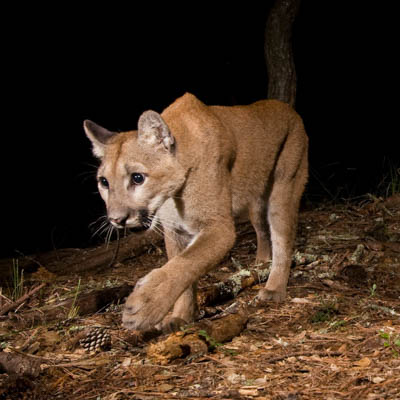A new study led by UC Santa Cruz researchers suggests that pumas in the Santa Cruz Mountains don’t make accurate assessments of where they are most likely to be killed by humans, especially when it comes to the threat of being killed in retaliation for loss of livestock.
Mountain lions fear humans and alter their behavior in order to avoid areas with high housing density, where human activity is most obvious. But it’s actually areas of intermediate housing density that prove the most lethal for pumas in the Santa Cruz Mountains. That’s largely because these areas are where conflicts arise over livestock. Between 2009 and 2019, the leading cause of death for mountain lions in the region was “retaliatory killings,” where a landowner kills a puma for preying on livestock—most often goats kept in small numbers on rural residential properties.
Researchers analyzed data on retaliatory killings over this 10-year time period and found that they accounted for 36% of all puma mortality and the majority of human-caused deaths. The team then looked for patterns in the distribution of risk from these killings over space and time. They compared this with tracking data from pumas outfitted with GPS collars, which shows how the cats choose habitats. This comparison demonstrated what is likely a mismatch between pumas’ perception of risk and actual risk from humans over 17% of the study area.
Chris Wilmers, a professor of environmental studies who leads the Santa Cruz Puma Project, was the senior author on the paper, and Anna Nisi, a former graduate researcher in Wilmers’ lab, was the study’s lead author. The team believes their findings show that humans are “unpredictable predators” for pumas.
“The people who carry out retaliatory killings are distributed in places where there are fewer cues related to overall levels of human activity that pumas can use to understand risk,” Nisi explained. “So, while pumas usually behave in ways that allow them to avoid encountering humans, there are places that appear safe to them that actually carry a lot of risk.”
Pumas did tend to avoid regions of intermediate housing density during the day, but they seemed to actually prefer these high-risk habitats at night. Researchers didn’t find any indication that this was related to hunting behavior. Domestic animals make up only 4% of puma diets, and the team’s analysis showed that pumas killed for preying on livestock weren’t skinnier than others and hadn’t gone longer since the last kill of their primary food source: deer. This means pumas likely weren’t attracted to these areas because of the opportunity to eat livestock. The research team has a different theory.
“Pumas' spatial requirements are quite large, which means that, in the Santa Cruz Mountains, most animals have some degree of habitat fragmentation in their home ranges,” Nisi said. “We think the reason why we see them using these intermediate housing density areas at night is that they simply need to traverse these spaces, so they end up doing that at night, when there's less chance of encountering a person.”
Unfortunately, crossing these areas at night doesn’t spare pumas from chance encounters with livestock. And if a mountain lion seizes the opportunity for an easy meal, they may then become a target for retaliatory killing. Hunting or killing of mountain lions has been illegal in California since 1990, but there are exceptions for the protection of livestock. The California Department of Fish and Wildlife issues “depredation permits” that allow for killing of mountain lions in verified instances when a domestic animal has been attacked.
The vast majority of retaliatory killings analyzed in the study were permitted. However, after the study period, the process for issuing depredation permits in the Santa Cruz Mountains changed significantly. In 2020, local pumas received temporary special protections as part of a proposal to list certain regional populations of mountain lions under the California Endangered Species Act. These temporary protections require a step-wise process of nonlethal efforts to deter mountain lions before a depredation permit can be issued.
Nisi says improved animal care practices—like keeping livestock in a covered enclosure at night—can significantly reduce the risk of pumas preying on domestic animals. If the proposal to list local mountain lions under the California Endangered Species Act is approved, these types of nonlethal measures might become a first-resort on a more permanent basis. Also, Chris Wilmers, who has been studying local mountain lions for over a decade, says he hopes the new paper’s findings will draw attention to the broader issue of how development patterns set the stage for conflict.
“This study is an example of how low-density, exurban areas are where we see the most human-wildlife conflict, and that can turn a place that could have been a potential habitat into an area with high mortality,” Wilmers said. “I think that should give us pause about how much of this type of sprawl we're allowing across the landscape, especially since it’s the most rapidly increasing kind of development throughout the American West.”



